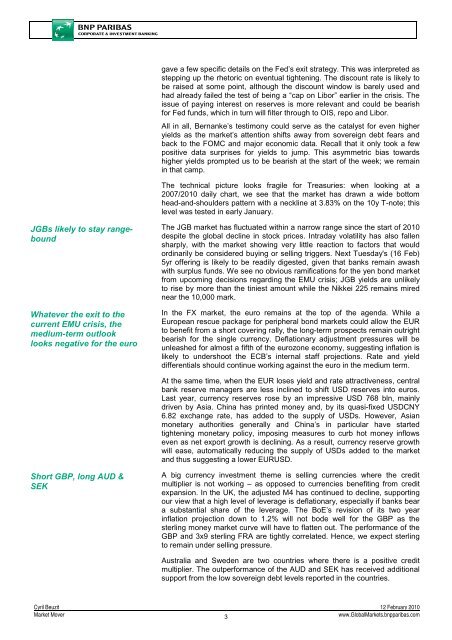Market Mover - BNP PARIBAS - Investment Services India
Market Mover - BNP PARIBAS - Investment Services India
Market Mover - BNP PARIBAS - Investment Services India
Create successful ePaper yourself
Turn your PDF publications into a flip-book with our unique Google optimized e-Paper software.
gave a few specific details on the Fed’s exit strategy. This was interpreted as<br />
stepping up the rhetoric on eventual tightening. The discount rate is likely to<br />
be raised at some point, although the discount window is barely used and<br />
had already failed the test of being a “cap on Libor” earlier in the crisis. The<br />
issue of paying interest on reserves is more relevant and could be bearish<br />
for Fed funds, which in turn will filter through to OIS, repo and Libor.<br />
All in all, Bernanke’s testimony could serve as the catalyst for even higher<br />
yields as the market’s attention shifts away from sovereign debt fears and<br />
back to the FOMC and major economic data. Recall that it only took a few<br />
positive data surprises for yields to jump. This asymmetric bias towards<br />
higher yields prompted us to be bearish at the start of the week; we remain<br />
in that camp.<br />
The technical picture looks fragile for Treasuries: when looking at a<br />
2007/2010 daily chart, we see that the market has drawn a wide bottom<br />
head-and-shoulders pattern with a neckline at 3.83% on the 10y T-note; this<br />
level was tested in early January.<br />
JGBs likely to stay rangebound<br />
Whatever the exit to the<br />
current EMU crisis, the<br />
medium-term outlook<br />
looks negative for the euro<br />
The JGB market has fluctuated within a narrow range since the start of 2010<br />
despite the global decline in stock prices. Intraday volatility has also fallen<br />
sharply, with the market showing very little reaction to factors that would<br />
ordinarily be considered buying or selling triggers. Next Tuesday's (16 Feb)<br />
5yr offering is likely to be readily digested, given that banks remain awash<br />
with surplus funds. We see no obvious ramifications for the yen bond market<br />
from upcoming decisions regarding the EMU crisis; JGB yields are unlikely<br />
to rise by more than the tiniest amount while the Nikkei 225 remains mired<br />
near the 10,000 mark.<br />
In the FX market, the euro remains at the top of the agenda. While a<br />
European rescue package for peripheral bond markets could allow the EUR<br />
to benefit from a short covering rally, the long-term prospects remain outright<br />
bearish for the single currency. Deflationary adjustment pressures will be<br />
unleashed for almost a fifth of the eurozone economy, suggesting inflation is<br />
likely to undershoot the ECB’s internal staff projections. Rate and yield<br />
differentials should continue working against the euro in the medium term.<br />
At the same time, when the EUR loses yield and rate attractiveness, central<br />
bank reserve managers are less inclined to shift USD reserves into euros.<br />
Last year, currency reserves rose by an impressive USD 768 bln, mainly<br />
driven by Asia. China has printed money and, by its quasi-fixed USDCNY<br />
6.82 exchange rate, has added to the supply of USDs. However, Asian<br />
monetary authorities generally and China’s in particular have started<br />
tightening monetary policy, imposing measures to curb hot money inflows<br />
even as net export growth is declining. As a result, currency reserve growth<br />
will ease, automatically reducing the supply of USDs added to the market<br />
and thus suggesting a lower EURUSD.<br />
Short GBP, long AUD &<br />
SEK<br />
A big currency investment theme is selling currencies where the credit<br />
multiplier is not working – as opposed to currencies benefiting from credit<br />
expansion. In the UK, the adjusted M4 has continued to decline, supporting<br />
our view that a high level of leverage is deflationary, especially if banks bear<br />
a substantial share of the leverage. The BoE’s revision of its two year<br />
inflation projection down to 1.2% will not bode well for the GBP as the<br />
sterling money market curve will have to flatten out. The performance of the<br />
GBP and 3x9 sterling FRA are tightly correlated. Hence, we expect sterling<br />
to remain under selling pressure.<br />
Australia and Sweden are two countries where there is a positive credit<br />
multiplier. The outperformance of the AUD and SEK has received additional<br />
support from the low sovereign debt levels reported in the countries.<br />
Cyril Beuzit 12 February 2010<br />
<strong>Market</strong> <strong>Mover</strong><br />
3<br />
www.Global<strong>Market</strong>s.bnpparibas.com
















